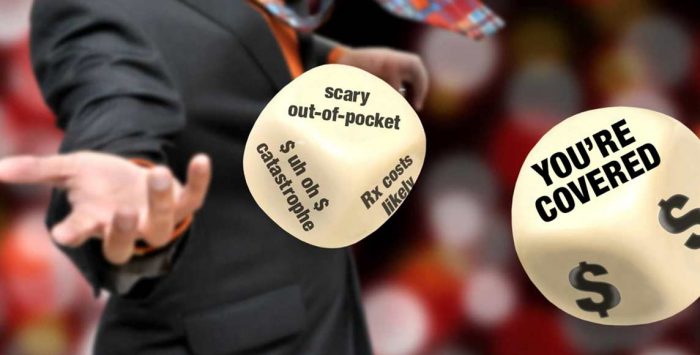Original Medicare: Key takeaways
If you’re approaching Medicare eligibility, you’ve probably heard about the various private-coverage options that are available to replace or supplement Medicare. These plans are popular, but are they necessary?
If you shun private coverage, can you get by on Original Medicare without purchasing supplemental coverage (Medigap and Part D prescription coverage) or using a Medicare Advantage plan?
The answer is: It depends.
When Original Medicare might be sufficient
For many low-income Medicare beneficiaries, there’s no need for private supplemental coverage. Almost one in five Medicare beneficiaries are dual eligible for both Medicare and Medicaid.
>This includes Medicare enrollees (both Original Medicare and Medicare Advantage) who are eligible for full Medicaid as well as those who qualify for Medicare Savings Programs that help low-income seniors pay premiums and cost-sharing under Original Medicare.
For dual-eligible enrollees who qualify for full Medicaid, that coverage picks up where Medicare leaves off, covering coinsurance and deductibles, as well as services not covered at all by Medicare (such as dental, vision, and long-term care). For Medicare beneficiaries who qualify for Medicare Savings Programs but not full Medicaid, there are varying levels of assistance available depending on the enrollee’s income.
Those who receive the least assistance (Original Medicare premium assistance only, but no help with coinsurance or deductibles) might find a Medigap plan to be beneficial, but most Medicare Savings Program enrollees do not have additional coverage under a Medigap plan.
Most don’t rely on Original Medicare alone
So for low-income Medicare beneficiaries, public programs are available to fill in the gaps in Medicare coverage. And 30% of Medicare beneficiaries receive employer or union-sponsored benefits that supplement Medicare. But what about the rest of the population?
Is Original Medicare enough coverage on its own? Most Medicare beneficiaries don’t think so: Only 19% of Original Medicare beneficiaries have no supplemental coverage (either from Medicaid, an employer-sponsored plan, or Medigap).
If you’ve got significant funds that you wouldn’t mind using to pay out-of-pocket expenses, you could get by with just Original Medicare. The main risks are the fact that it doesn’t have a cap on out-of-pocket costs, and it doesn’t cover outpatient prescription drugs (Medicare Part D covers prescriptions, but that’s a separate policy that enrollees buy as stand-alone coverage, unless they enroll in a Medicare Advantage plan that includes integrated Part D coverage).
Discuss your coverage options with a licensed Medicare advisor at 1-844-309-3504.
Preventing major expenses
There are certainly people who contend that even though Original Medicare has no cap on out-of-pocket costs, it is still plenty of coverage – and for the average enrollee, that’s probably true. But the purpose of insurance is to protect us against significant losses.
Or call
866-472-0949 (TTY 771) to speak to a licensed insurance agent
(Mon-Fri 8am-9pm, Sat 10am-7pm ET)
Although most hospitalizations last less than a week, my father was hospitalized for 136 days in 2004. With a similar hospital stay using 2021 cost-sharing requirements, his Medicare Part A (inpatient) out-of-pocket without a Medigap plan would have been $1,484 for the first 60 days, $11,130 for the next 30 days (at $371/day), and $34,132 for the final 46 days (at $742/day), for a grand total of $46,746 — that would have been the amount he had to pay, after Medicare paid its share.
He recovered, and has been quite healthy ever since he got a kidney transplant in 2012. But even after his long inpatient stay, he needed dialysis for the next eight years. Medicare Part B currently pays an average of about $235 per treatment for hemodialysis. That’s the 80% that Medicare pays, and the patient is responsible for the other 20%.
Without supplemental insurance, that works out to a patient responsibility of about $60 per session. And standard dialysis treatment is about 13 sessions per month, meaning the patient would pay roughly $780 per month for dialysis alone – not counting any additional outpatient care that might be necessary.
So although it’s true that normal-length hospital stays, regular office visits, and the odd MRI would be affordable for most people with just Original Medicare, there are certainly medical conditions that would be difficult for the average person to finance without supplemental coverage.
Feeling lucky?
If you never get seriously ill, and if you only ever need the occasional generic prescription, you’ll be fine with Original Medicare alone. But who among us can accurately predict whether or not a catastrophic medical condition will befall us at some point in the future?
Although Original Medicare provides a solid insurance base, the lack of prescription coverage or an out-of-pocket maximum can leave beneficiaries on shaky ground if they develop a significant medical condition. If you prefer to have a little more predictability in your health care costs, it’s wise to consider either a Medicare Advantage plan or Original Medicare supplemented with a Medigap policy and a Part D policy.
Louise Norris is an individual health insurance broker who has been writing about health insurance and health reform since 2006. She has written dozens of opinions and educational pieces about the Affordable Care Act for healthinsurance.org. Her state health exchange updates are regularly cited by media who cover health reform and by other health insurance experts.









